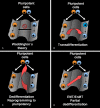Transdifferentiation of endothelial cells to smooth muscle cells play an important role in vascular remodelling
- PMID: 25973327
- PMCID: PMC4396157
Transdifferentiation of endothelial cells to smooth muscle cells play an important role in vascular remodelling
Abstract
Pulmonary artery remodelling it is a major feature of pulmonary hypertension (PH). It is characterised by cellular and structural changes of the pulmonary arteries causing higher pulmonar vascular resistance and right ventricular failure. Abnormal deposition of smooth muscle-like (SM-like) cells in normally non-muscular, small diameter vessels and a deregulated control of endothelial cells are considered pathological features of PH. The origin of the SM-like cells and the mechanisms underlying the development and progression of this remodelling process are not understood. Endothelial cells within the intima may migrate from their organised layer of cells and transition to mesenchymal or SM-like phenotype in a process called endothelial-mesenchymal transition (EnMT). Traditionally, Waddington's epigenetic landscape illustrates that fates of somatic cells are progressively determined to compulsorily follow a downhill differentiation pathway. EnMT induces the transformation of cells with stem cell traits, therefore contrasting Waddington's theory and confirming that cell fate seems to be far more flexible than previously thought. The prospect of therapeutic inhibition of EnMT to delay or prevent PH may represent a promising new treatment modality.
Keywords: Endothelial to mesenchymal transition; cellular reprogramming; endothelial cells; pulmonary hypertension; remodelling.
Figures


References
-
- McLaughlin VV, McGoon MD. Pulmonary arterial hypertension. Circulation. 2006;114:1417–31. - PubMed
-
- Eddahibi S, Morrell N, d’Ortho MP, Naeije R, Adnot S. Pathobiology of pulmonary arterial hypertension. Eur Respir J. 2002;20:1559–72. - PubMed
-
- Rubin LJ. Primary pulmonary hypertension. N Engl J Med. 1997;336:111–7. - PubMed
